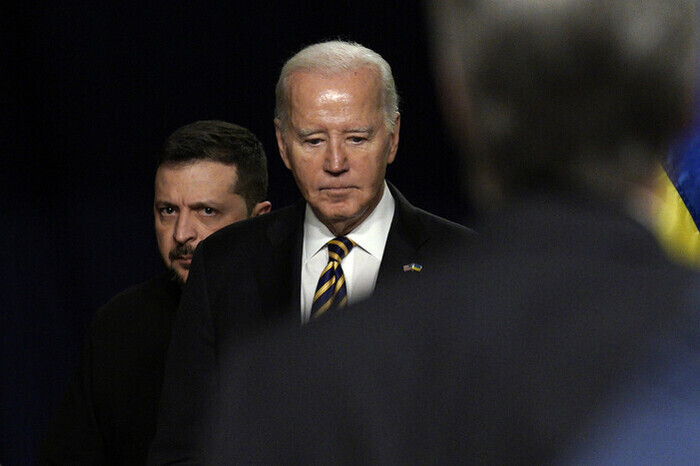[Column] The shadow of America’s failure hangs over Ukraine
Posted on : 2024-01-18
The US’ lopsided diplomacy has been a boon for its rivals, a lesson Korea would do well to take to heart

US President Joe Biden and Ukrainian President Volodymyr Zelenskyy head into a joint press conference following a summit on Dec. 12, 2023. (UPI/Yonhap)

By Pak Noja (Vladimir Tikhonov), professor of Korean Studies at the University of Oslo
Much like the Korean War that raged from 1950 to 1953, the war in Ukraine is complicated and multi-layered in nature. The Korean War started as a civil war defined by armed conflict between two sides of a nation, only to evolve into an international fight between the Sino-Soviet bloc and the US-centered Western bloc.
In comparison, the war in Ukraine was triggered by an imperialist invasion made by Putin in an attempt to restore Russia’s former empire. However, when Putin’s attempt to speedily achieve his goal failed and the US and its allies started to become involved, this war, too, became an international affair.
As a war between NATO and Russia — with the backing of Belarus, North Korea and Iran — it has inadvertently taken on the appearance of a proxy war between the US and Russia.
Continuing the comparison between the Korean War and the war in Ukraine, in this US-Russia proxy war, the US has the overwhelming upper hand in terms of power compared to 70 years ago. If we are to only look at military spending by the US, its budget alone is 10 times larger than that of Russia. Even Russian soldiers acknowledge the force commanded by the weapons made in the US, demonstrated by how the US’ cannons have a longer range than their Russian counterparts.
Despite that advantage, the US was unable to achieve any significant victories against their much weaker opponent on the battlefield of Ukraine at any point last year. In fact, Russia has managed to occupy more, not less, Ukrainian territory than before, having seized around 18 percent.
The US also failed to achieve its goal of bringing the Russian military to its knees through its indirect involvement in the conflict. With the situation turning into positional warfare stuck in stalemates on all fronts, it would be difficult to say that the Russian military, which uses five times as many artillery shells as the Ukrainians on a daily basis, has taken a significant blow.
Why has Ukraine, which received a whopping, historically unprecedented US$100 billion in aid from the superpower of the US since Feb. 24, 2022, been driven into a pinch by Russia, which does not possess the same financial resources or military technology as the US?
Whether a war is won or lost is decided by various factors. Yes, strategy and tactics are the most basic of these, but victory on the battlefield is built on the procurement of goods. In other words, one must be victorious in the “production war” by increasing the production of military goods.
Also, in order to continue to have enough supplies necessary for battle, negotiation and communication are imperative. Successfully isolating an opponent on the diplomacy and trade fronts increases the likelihood of winning the war.
Constructing a convincing narrative concerning the end goal of the war and its objectives to persuade parties not involved in the war as well as the citizens of the opposing country is also crucial to winning the hearts of the public and undermining the opposing regime’s position.
The US has been the deciding factor on the Ukrainian side when it comes to these aforementioned four factors, but has also failed miserably on all of those fronts.
When on the subject of strategy and tactics on the battlefield, it is impossible to not mention that Ukraine submitted to the Pentagon a plan to retake its southern regions and advance into the Crimean Peninsula in late 2022, when the tide was still somewhat in Ukraine’s favor.
Ukraine, which had been armed with superior US-made weapons and possessed high morale, could have given Putin a crushing defeat that would’ve been immortalized in history textbooks if it had advanced as planned, as Russia had yet to establish defenses in that region.
But the Pentagon, wary of cornering Putin at a time of heightened tensions in the US-China conflict and elsewhere, rejected the plan.
Ukraine, unable to go against the wishes of its most generous partner, had no choice but to focus on retaking the northern region. Its “grand counteroffensive” to retake the south finally took place in the summer of 2023, only for the country to suffer greatly, as Russia had had the time to establish a line of defense in that region.
The US’ incongruous stance on the war, caused by its urge to leave room for compromise with Putin, ultimately rendered the enormous sacrifices of Ukrainian soldiers useless.
Those sacrifices have been compounded by the US’ continued failures to increase the production of shells and other war materials, which are of the utmost importance in position warfare that relies on artillery power.
Russia is capable of producing around 1.5 million shells per year, while importing more from Belarus or North Korea. For Ukraine to fight it on equal terms, it would need roughly as many.

Wars in Gaza (left) and Ukraine (right) continue raging in the new year. (AFP/Yonhap)
But the US is currently only capable of producing around 336,000 shells a year, and the capacities of Europe as a whole aren’t any greater. Russia still has Soviet-era shell production facilities as state-run enterprises, whereas investment in increased shell production is not an easy decision for European and American private munitions companies, which are expecting the war in Ukraine to finish in another year or two, with the demand for shells plummeting once it’s over.
In effect, neoliberal capitalism, where profit is the priority consideration, is incapable of overcoming Putin’s brand of state capitalism in a wartime situation like this one.
Winning the war would require cutting off Russia’s trade networks, through which it is importing the necessary components and machinery for weapon manufacturing from places like China, the Gulf states and Türkiye.
Even if we take into account the quasi-alliance between China and Russia, the US — which has prioritized its alliance with Israel in the Middle East — has failed to provide Türkiye or the Gulf states with convincing reasons for taking part in the sanctions against Russia. The US’ lopsided diplomacy favoring Israel has not changed even amid the genocidal atrocities that are still taking place in Gaza, and this situation has created an environment where Putin and Beijing are easily able to win support from Middle Eastern nations and countries in the Global South.
Not only that, but the US’ approach of overtly presenting the “weakening” of Russia as its objective in this war — rather than the restoration of the democracy ravaged by the dictator Putin — has led to even pro-Western members of Russia’s middle class conditionally throwing their support behind Putin as the war goes on.
The factors behind the US’ failures in Ukraine, in spite of the unimaginable sacrifices that the Ukrainian public has made amid Putin’s aggressions, include Ukraine’s military subordination to the US, the limits of what neoliberal economies can achieve in a wartime situation, and the US’ myopically nationalistic approach and declining influence along the margins of the global system.
These failures should be taken as a lesson for us.
Please direct questions or comments to [english@hani.co.kr]
Related stories· [Column] The significance of closer Pyongyang-Moscow ties missed by Western media
· [Column] Neo-authoritarianism is feeding off isolation
· [Column] Return of the Cold War, or something older?
· [Column] The war in Ukraine is a moment of truth
No comments:
Post a Comment